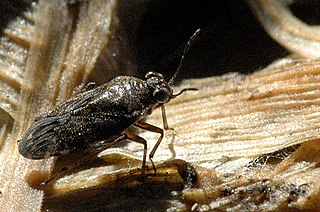
Saldidae, also known as shore bugs, are a family of insects in the order Hemiptera. They are oval-shaped and measure 2–8 mm (0.08–0.31 in) when mature. Typically they are found near shorelines or the marginal growths near freshwater bodies, estuaries, and sea coasts. They can flee by leaping or taking flight. There are about 350 recognized species with the majority from the Nearctic and Palearctic. Many species are found in the intertidal zone and both adults and nymphs of some species like Saldula pallipes can tolerate submergence at high-tide. Saldidae are predators and scavengers. They pass the winter through egg or adult diapause.

Nabis flavomarginatus is a species of damsel bug in the family Nabidae.

Nabis limbatus is a species of damsel bug in the family Nabidae. It is found in Northern Europe and the northern part of Western and Central Europe. It occurs in the East in Eastern Europe and across the Palearctic to Siberia to China and Korea. It is introduced in Canada. In the Alps, it rises to about 1400 meters above sea level. In the South of Europe, it is found only in the central uplands.

Nabis lineatus is a species of damsel bug in the family Nabidae.

The Tingidae are a family of very small insects in the order Hemiptera that are commonly referred to as lace bugs. This group is distributed worldwide with about 2,000 described species.
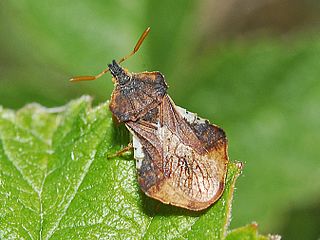
Phymata crassipes is a species of assassin and thread-legged bugs belonging to the family Reduviidae, subfamily Phymatinae.
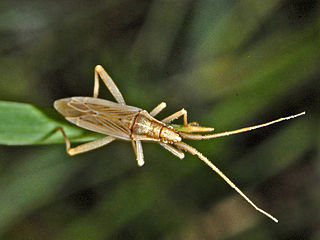
Stenodema holsata is a species of bug from the family Miridae.

Capsus ater is a species of bug in the Miridae family that likely originated in North America, but that is now found in Europe and across the Palearctic to Siberia and in North America.

Orthops campestris is a species of plant bugs belonging to the family Miridae, subfamily Mirinae, that can be found everywhere in Europe except for Azores, Faroe Islands, Iceland and African islands such as Canary Islands and Cyprus. and across the Palearctic to Central Asia and Siberia.
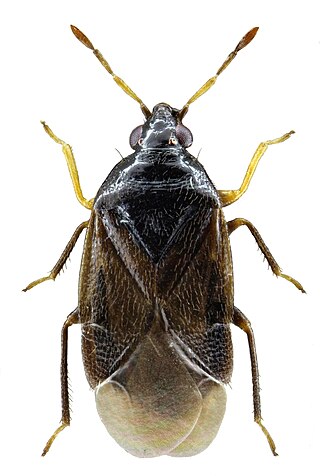
Orius niger is a true bug. The species is found in the Palearctic from Europe east to Siberia and across Central Asia to China and India. It is widespread in Central Europe mostly in the south. In the Alps it is found up 1600 meters above sea level.
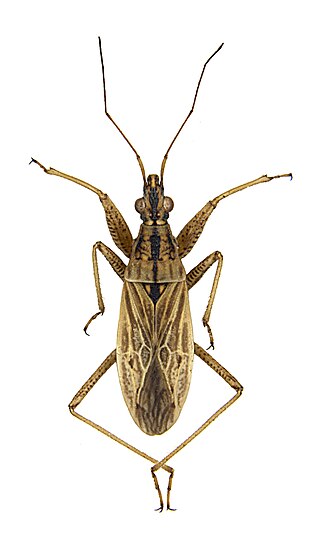
Nabis rugosus, the common damsel bug, is a predatory true bug. The species is found in the Palearctic. It is found in Europe from the North edge of the Mediterranean to southern Scandinavia. Further east, the distribution extends east across the Palearctic to Central Asia and Siberia. The species occurs everywhere in Central Europe and is found in the lowlands, as well as in the central uplands and in the Alps up to about 1500 meters above sea level. It is Central Europe's most common species of sickle bug and it is found in many different habitats, open, dry, shaded and moist; but it prefers moderately moist, half shady places with dominant grass. Adjacent woodland vegetation is equally important.
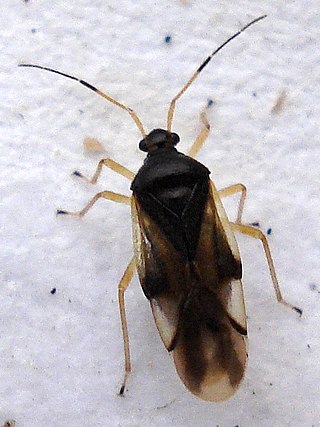
Bryocoris pteridis is a true bug in the family Miridae. The species is found in Europe from Ireland in the West and including the northern edge of the Mediterranean and the East across the Palearctic to Siberia.In Central Europe, it is widespread and occurs both in the central uplands and the Alps up to 1500 metres above sea level.

Monalocoris filicis is a true bug in the family Miridae. The species is found in Europe from Ireland in the West and including the northern edge of the Mediterranean and the East across the Palearctic to Central Asia, Korea and Japan. In Central Europe, it is widespread and generally common. In the Alps, it occurs up to the edge of the forest. Habitats are deciduous and coniferous forests and moist, open habitats such as bogs or the shores of streams.
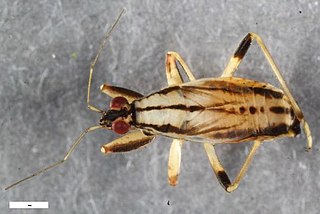
Himacerus boops is a species of damsel bug in the family Nabidae. It is found from South Scandinavia and the South of the British Isles over Western and Central Europe and East across the Palearctic to Siberia and in the Caspian region. They are not present in most parts of the Mediterranean.
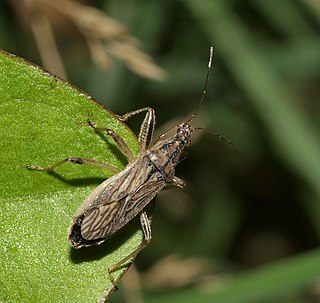
Himacerus major is a species damsel bug in the family Nabidae. It is found in the Holarctic. The range is from South Scandinavia and the South of the British Isles over West Europe including the Western Mediterranean, Central Europe and Eastern Europe and in the Caucasus. It is also found in North America. Himacerus major occurs in many different habitats with grass, regardless of the level of humidity. The species occurs on very dry dune habitats, and nutrient-poor grasslands,as well as wet shores of waters without woody vegetation and salt places inland. The species occurs in very large numbers near the coast of the Northern Baltic Sea. It is absent from woodland.

Drymus brunneus is a species of dirt-colored seed bug in the family Rhyparochromidae found in the Palearctic. In the West Palearctic it is lacking only in the far north of Northern and Eastern Europe. In the East, the species ranges to the Caucasus and Siberia.

Orthonotus rufifrons is a species of plant bugs belonging to the family Miridae.

Plagiognathus arbustorum is a species of insects in the family Miridae, the plant bugs.

Nagusta goedelii is a species of assassin bugs in the family Reduviidae.
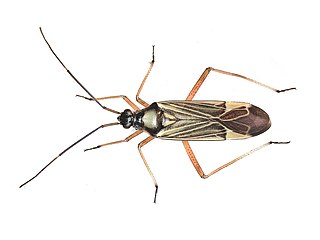
Miris striatus is a Palearctic species of true bug that is the type species of the type genus of the family Miridae. It has been reported to be a predator of psyllids such as Cacopsylla melanoneura.




















